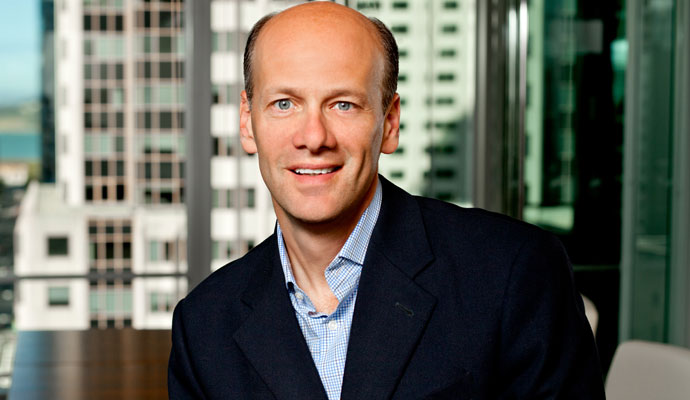Silicon Valley’s Farsighted Banker
SVB CEO Greg Becker on where and how the next big tech innovations will emerge.
A version of this article appeared in the Winter 2016 issue of strategy+business.
Headquartered in Santa Clara, Calif., the Silicon Valley Bank (SVB) has a privileged view of the prospects of the companies around it. SVB provides financial services to innovative companies — including leading-edge software and life sciences companies, as well as premium winemakers — and it often connects innovators and potential partners with one another. CEO and president Greg Becker is also noteworthy for his ability to see the big picture, the overall positive growth in technology, which encompasses activity at all the companies in the industry.
While he is bullish on the future because of the technological value he sees evolving, Becker is also mindful of the enormous challenge facing his clients: access to talent. It still remains too difficult, in his view, to find the highly skilled talent needed for the many technology jobs available.
In this interview with strategy+business, conducted as part of PwC’s 2016 U.S. CEO Survey, Becker explains the view from a financier’s office — and tells us why the innovation ride that Silicon Valley has taken the world on is just getting started.
S+B: How has the technology industry changed during the time you’ve been here?
BECKER: I’ve been at this bank since 1993, and I’m more optimistic today than I ever have been about the impact innovative companies are having on the global economy.
Everything is changing with the adoption of mobile, with generational changes, and with people being more comfortable using technology. Today you see companies growing from small to multibillion-dollar corporations in three or five years. We’re going to see truly astonishing things in the next three to five years — whether it’s in software, consumer [goods], clean tech, or biotech.
You have to compare today to the 1999–2000 time period when you had business models that didn’t make sense, revenues that weren’t there, and high valuations. Both business models and valuations were in a bubble. Today, the business models are good. I would argue that valuations are high and they’re priced for perfection, but it’s not as if these businesses are going to go away. The valuations may go down, but it’s just very different from what it was back then.
S+B: Where do you see the most useful new ideas and businesses emerging?
BECKER: First, let’s talk about sectors. Cybersecurity is an area that we have to continually invest in. It used to be financial institutions that were the key drivers of this sector, but now people realize every business will need it. For the long term, that is going to be an area of growth.
Then there’s anything related to mobile, or anything [having to do] with software as a service — or where you can put software in the cloud — and, finally, personalized medicine. What’s so great is that there are not just one or two things, but a dozen different areas that are all incredibly exciting.
Now let’s talk about geography. Ten or 15 years ago, Silicon Valley was the hub of innovation, and it’s still the dominant place, but now innovation is being distributed throughout the United States and throughout the world. You see Boston and New York competing for second place. Third position is other places around the United States. Globally, the U.K. is becoming a hub for financial technology (FinTech) innovation. China is doing more innovation, broadly speaking, across the platform, mainly for its own market. Increasingly, companies that are successful in China are coming to the United States, through either investment or acquisition. That’s an area we didn’t expect.
Silicon Valley won’t be as important as it was, but at the same time it has become even more concentrated than it was maybe a decade ago.
S+B: What else should we keep an eye on?
BECKER: Machine learning is a big area in FinTech and for data and analytics companies as well. It’s basically having computers take unstructured data to learn more in order to become smarter.
“I would argue that valuations are high and they’re priced for perfection, but it’s not as if these businesses are going to go away.”
We have clients that are doing more in the drone category. Would you have believed people five years ago if they said that they were going to start delivering packages with drones? I’m still a little bit skeptical, but what is happening now with drones is amazing. We are also involved in the medical devices sector and life sciences in general. Too often people look at those industries and say, “That’s really interesting, but it’s so expensive.” These discoveries cost an incredible amount of money, because of the regulatory requirements and because of their complexity. Companies have to make a return on the risk they’re taking in developing drugs or medical devices.
S+B: What financial-sector innovations are you looking at?
BECKER: Agile software development has been important for a while in the software industry, but banks are now using it. The companies that aren’t embracing it are going to fall behind.
We have a team of people helping FinTech companies, and we think that’s a big area for growth for us for the coming years. We work with incumbent banks that don’t want to be part of it, and we are also working with the new upstarts at the same time. We do this by being part of their infrastructure, part of their payment structure. Payments are interesting. A lot of FinTech companies are interested in user experience, but they want to stay away from the regulatory side. Any time you start interacting with the Fed and payments, you become regulated, for the most part. So if we can take care of that and they take care of their client experience, it’s a partnership that’s a win for us and for them.
S+B: What are the biggest challenges in this sector today?
BECKER: The regulations are more and more challenging. It seems we’re in an era where the perception is that more regulation of banks is better. But are the regulations that are being put in place truly there to manage risk and provide a benefit that constituents and people are concerned about? Or are we just adding on more because we think that it will lower risk? We really have to get back to what’s important. As a bank CEO, I’m a big believer in risk management. But I think too much of it is regulation without the real knowledge that it is lowering risk or changing that risk dynamic.
We’re in a business that’s about taking risk. We have to take risk, or we won’t be in business. We understand that, but we also understand that we have a responsibility to shareholders and to depositors, so it’s that balance that we need to take a better look at.
S+B: What about your joint venture in China?
BECKER: We looked at China 15 years ago and said, if we’re going to be the bank for the global innovation economy, we have to figure out which markets are going to be leading markets, and then figure a way to approach them. China has always been one of those. The question is, how do you go there and what’s the best approach for success? We thought we could go on our own, and we do have operations there on our own. We decided, however, to make a real, big presence there — and we believed that the only way to make it truly successful was by partnering.
The best chance we had was to partner with a successful institution that had the best values, style, and approach. We partnered with Shanghai Pudong Development Bank, creating the first 50–50 commercial bank joint venture in China. We got that license in 2010, and the joint venture recently got an RMB license. We believe it’s best to partner with a local to really see the maximum benefit over time.
S+B: Is access to talent still a major concern?
BECKER: If you talk to our client base and ask them what their challenges are, access to talent is absolutely the biggest one. You’ve seen that in Silicon Valley, especially with compensation levels going through the roof. If this problem isn’t solved, it is going to backfire on Silicon Valley to some extent. More companies are going to start looking in other places, because hiring is just too expensive.
There are a variety of ways to get it solved. One is by developing people, training people. We aren’t graduating nearly enough people out of our universities with STEM degrees to satisfy the high-paying jobs that are open.
For the most part, in Washington, Democrats and Republicans all agree that immigration reform needs to happen for high-skilled people. The fact that it doesn’t happen is so frustrating because there are jobs that need to be filled. The choice is whether high-skilled immigrants can come, stay here long term, and help develop the talent base here, or whether jobs will move overseas. And that’s the part where I don’t think Washington gets the message. The feeling there is, “We’ll just hire Americans.” But the U.S. doesn’t have candidates. We don’t have enough prospective workers graduating. That’s a big challenge, and it’s a big frustration for our clients.
S+B: Do you feel there are certain things that should get more emphasis in business coverage?
BECKER: I would love to be able to expose two areas. One is the value add that we give our clients, whether it’s making an introduction to a potential client, or making an introduction to a potential partner. Why is that so important with technology companies? The most important thing to technology companies is speed in execution. I can’t guarantee that if a client works with us they’re going to be successful, but I can guarantee that the probability they’ll be successful is higher.
And why is that? Well, because we’re so concentrated in the target markets we go after. There’s a greater chance that we have a greater ability than another institution to introduce one CEO to another who’s going through the same challenges. Our ability to make an introduction to a potential partner is greater because we understand the business better than our competitors. We spend a lot of time on that. We don’t spend enough time talking about it, so we would love to have more of those stories told.
Number two, we do a lot in the community. I want our employees to feel good about the company because of what we do in the community. One way to support the community is by just giving money, and that’s great. Another way to support it is by truly getting your employees engaged. We hire the sort of people who want to get involved. We don’t do it to get the PR exposure. The message is more about getting the employees who fit our culture as opposed to generating a marketing opportunity.
Our work in the community is multifaceted. We want to support our employees in all the different things they do, so we have a foundation. If you’re an employee and you’re engaged — you may be on the board, you may be actively involved in some way — our foundation looks to support that. Our employees decide what gets supported and what doesn’t.
One example is an organization called Best Buddies that helps individuals, young adults mainly, with intellectual disabilities get jobs, get trained and developed, and find friendships. We won the Best Buddies Employer of the Year award, and that means we’re helping those individuals accomplish what they want to accomplish.
S+B: What technology do you most wish was available that isn’t yet today?
BECKER: A time machine to give us more hours in the day. There are more things that need to get done.
Reprint No. 16403
Author profile:
- Chrisie Wendin is a director with PwC’s Thought Leadership Institute, based in Silicon Valley, and editor-in-chief of PwC's Next in Tech digital magazine.






